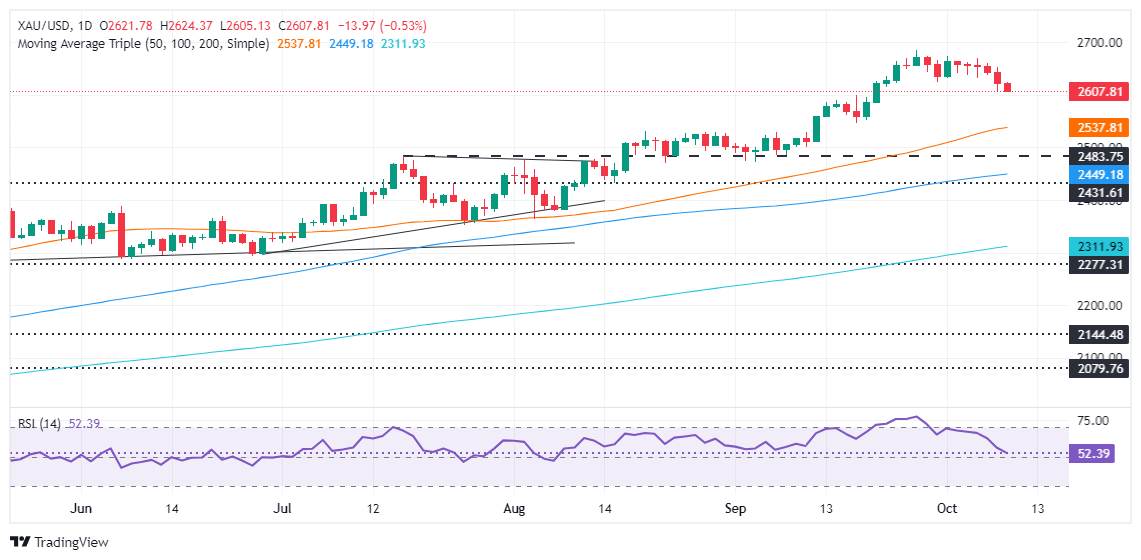Gold price tumbles as US yields surge after FOMC minutes

- Gold declined as Fed Minutes revealed a “substantial majority” backed a 50 bps cut, while some preferred 25 bps.
- CME FedWatch Tool shows lower odds of a 25 bps cut, down to 75.9%, with rising expectations for a rate pause.
- US 10-year Treasury yield rises to 4.062%, supporting the US Dollar.
- Traders await Thursday’s CPI data for further direction on inflation and Fed policy.
Gold extended its losses for the sixth consecutive day after the Federal Reserve (Fed) revealed its September Meeting Minutes. The Minutes showed that the “substantial majority” of the Federal Open Market Committee (FOMC) backed a 50-basis-point (bps) cut. Despite this, the XAU/USD trades within familiar levels near $2,610, down over 0.37%.
The FOMC’s Minutes showed that some officials would’ve preferred a 25 bps cut, though all participants favored lowering interest rates. Regarding the Fed’s dual mandate in both cases, almost all officials saw inflation risks tilted to the downside, while risks to the labor market were on the upside.
Following the data, the CME FedWatch Tool shows odds for a 25 bps interest rate cut were lowered from 85.2% a day ago to 75.9%. This means that some market participants positioned themselves toward the Fed holding rates unchanged, with odds at 24.1%, up from 14.8% on Tuesday.
US Treasury yields continued to rise with the US 10-year Treasury note at 4.062%, up five and a half bps. This underpinned the Greenback, which according to the US Dollar Index (DXY) is up 0.42% at 102.90, its highest level since mid-August 2024.
Now, traders’ focus shifts to Thursday’s release of the US Consumer Price Index (CPI). Estimates suggest that inflation will continue to aim lower. Nevertheless, if inflation comes in higher than estimates, it will open the door for a pause on the Fed’s easing cycle.
The US economic schedule for the week will feature US inflation, US jobs data and Fed speakers.
Daily digest market movers: Gold prices pressured by FOMC’s Minutes ahead of US CPI
- The US CPI is expected to decrease from 2.5% to 2.3% YoY. Monthly CPI is projected to come at 0.1%, down from 0.2%.
- Core CPI is foreseen to remain unchanged compared to August’s figure at 3.2% YoY. The September figure is estimated to dip from 0.3% to 0.2% MoM.
- Other data will reveal the Initial Jobless Claims for the week ending October 5. Projections suggest that 230K new people applied for unemployment benefits, above the prior reading of 225K.
- After Friday’s NFP report, Fed officials are more cautious. Vice-Chair Philip Jefferson said his approach is “meeting by meeting” and data-driven. Boston Fed President Susan Collins expects more rate cuts, also based on incoming data.
- Following the last US jobs report, recession fears faded. Therefore, most Wall Street banks like Citi, JPMorgan and Bank of America revised their November Fed call from a 50 to 25 bps rate cut.
- Meanwhile, the People’s Bank of China (PBoC) halted its Bullion purchases for the fifth month. China’s reserves were unchanged as they stood at 72.8 million troy ounces at the end of last month.
XAU/USD technical analysis: Gold price slips as sellers eye support underneath $2,650
Gold prices extended losses below $2,630 and dropped to a daily low of $2,605 as traders digested the FOMC’s September Meeting Minutes.
Short-term momentum is bearish even though the Relative Strength Index (RSI) shows mixed readings and stands in bullish territory.
XAU/USD has tumbled below $2,620. A breach of $2,600 will expose the psychological $2,550 mark ahead of the 50-day Simple Moving Average (SMA) at $2,537. Once these levels are surpassed, the $2,500 figure is up next.
Conversely, if Gold aims higher and reclaims $2,650, it will pave the way to challenge $2,670 ahead of the YTD high of $2,685.
Fed FAQs
Monetary policy in the US is shaped by the Federal Reserve (Fed). The Fed has two mandates: to achieve price stability and foster full employment. Its primary tool to achieve these goals is by adjusting interest rates. When prices are rising too quickly and inflation is above the Fed’s 2% target, it raises interest rates, increasing borrowing costs throughout the economy. This results in a stronger US Dollar (USD) as it makes the US a more attractive place for international investors to park their money. When inflation falls below 2% or the Unemployment Rate is too high, the Fed may lower interest rates to encourage borrowing, which weighs on the Greenback.
The Federal Reserve (Fed) holds eight policy meetings a year, where the Federal Open Market Committee (FOMC) assesses economic conditions and makes monetary policy decisions. The FOMC is attended by twelve Fed officials – the seven members of the Board of Governors, the president of the Federal Reserve Bank of New York, and four of the remaining eleven regional Reserve Bank presidents, who serve one-year terms on a rotating basis.
In extreme situations, the Federal Reserve may resort to a policy named Quantitative Easing (QE). QE is the process by which the Fed substantially increases the flow of credit in a stuck financial system. It is a non-standard policy measure used during crises or when inflation is extremely low. It was the Fed’s weapon of choice during the Great Financial Crisis in 2008. It involves the Fed printing more Dollars and using them to buy high grade bonds from financial institutions. QE usually weakens the US Dollar.
Quantitative tightening (QT) is the reverse process of QE, whereby the Federal Reserve stops buying bonds from financial institutions and does not reinvest the principal from the bonds it holds maturing, to purchase new bonds. It is usually positive for the value of the US Dollar.
